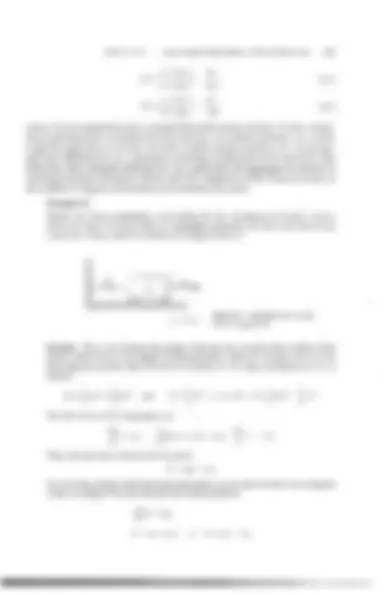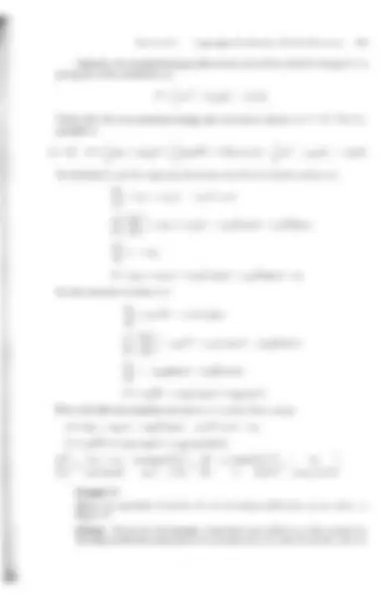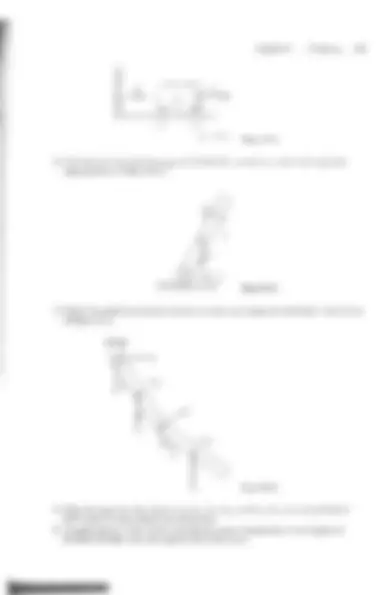










Study with the several resources on Docsity

Earn points by helping other students or get them with a premium plan


Prepare for your exams
Study with the several resources on Docsity

Earn points to download
Earn points by helping other students or get them with a premium plan
Community
Ask the community for help and clear up your study doubts
Discover the best universities in your country according to Docsity users
Free resources
Download our free guides on studying techniques, anxiety management strategies, and thesis advice from Docsity tutors
aricle RPR manipulator has the following transformation Introduction to Robotics (CS223A) Homework #4 Solution (Winter 2007/2008) 1. Consider the following RRRR manipulator (image courtesy J. J. Craig): Introduction to
Typology: Study Guides, Projects, Research
1 / 14

This page cannot be seen from the preview
Don't miss anything!









n
and Forces
In previous chapters, we studied the kinematic position and differential motions of robots. In this chapter, we will look at the dynamics of robots as it relates to acceler- ations, loads, and masses and inertias. We will also study the static force relation- ships of robots. As you remember from your dynamics course, to be able to accelerate a mass, we need to exert a force on it. Similarly, to cause an angular acceleration in a rotat- ing body, a torque must be exerted on it (Figure 4.1), as in
and 2: T = I· a. (4.1)
are capable of exerting large enough forces and torques on the links and joints to move them at a desired acceleration and. velocity. Otherwise, tbe link may not be moving fast enough, and thus the robot will lose its positional accuracy. To be able to calculate how strong each actuator must be, it is necessary to determine the dy- namic relationships that govern the motions of the robot. These equations are the force-mass-acceleration and the torque-inertia-angular acceleration relation- ships. Based on these equations and considering the external loads on the robot, the designer can calculate the largest loads to which the actuators may be subjected and thereby design the actuators to be able to deliver the necessary forces and torques. In general, the dynamic equations may be used to find the equations of motion of mechanisms. This means that knowing the forces and torques, one can figure out how a mechanism will move. However, in our case, we have already found the equa- tions of motions; besides, it is practically impossible to solve the dynamic equations
120 Chapter 4 Dynamic Analysis and Forces
Figure 4.1 Force-mass-acceleration and torque-inertia-angular acceleration relationsl1ips for a rigid body.
,'
of robots in all but the simplest cases. Instead, we will use these equations to find what forces and torques may be needed to induce desired accelerations in the robot's joints and links. These equations are also used to see the effects of different inertial loads on the robot and, depending on the desired accelerations, whether certain loads are important. For example, consider a robot in space. Although ob- jects are weightless in space, they do have inertia. As a result, the weight of objects tllat a robot in space may handle may be trivial, but its inertia is not. So long as the movements are very slow, a light robot may be able to move very large loads in space with little effort. This is why the robot used with the Space Shuttle program is very slender; but handles very large satellites. The dynamic equations allow the de- signer to investigate the relationship between different elements of the robot and design its components appropriately. In general, techniques such as Newtonian mechanics can be used to find the dynamic equations for robots. However, due to the fact that robots are three- dimensional, multiple-degree-of-freedom mechanisms with distributed masses, it is very difficult to use Newtonian mechanics. Instead, one may opt to use other tech- niques such as Lagrangian mecllanics. Lagrangian mechanics is based on energy terms only and thus in many cases is easier to use. Although Newtonian mechanics, as well as other techniques, can be used for this derivation, most references are based on Lagrangian mechanics. In this chapter, we will briefly study Lagrangian mechanics with some examples, and then we will see how it can be used to solve for robot equations. Since this course is primarily intended for undergraduate stUdents, the equations will not be completely derived, but only the results will be demon- strated and discussed. Interested students are encouraged to refer to other refer- ences for more detail [1,2,3,4,5,6,7].
Lagrangian mechanics is based on the differentiation of the energy terms with re- spect to the system's variables and time, as shownlJf.xt. For simple cases, it may take longer to use this technique than Newtonian mechanics. However, as the complexi- ty of the system increases, the Lagrangian method becomes relatively simpler to use. The Lagrangian mechanics is based on the following two generalized equations, one for linear motions, one for rotational motions. First we will define a Lagrang- ian as
L = K - P, (4.2)
where L is the Lagrangian, [( is the kinetic energy of the system, and P is the poten- tial energy of the system. Then
Solution In tbis problem, there are two degrees of freedom. two coordinates x and e, and there will be two equations of motion: one for the linear motion of the system and one for the rotation of the pendulum.
ma
F
Figure 4.4 Schematic of a cart- /112 pendulum system,
vi, = (~t + lil cos 8)2 + (lil sin W. .~
Kpendllium = '2 m2(~t + Ie cos 8)2 + '2 m2 (Ie sin 8) ,
K = Kcar • + J(pendlllum,
Figure 4.3 Free-body diagram for the spring-cart system.
Dynamic Analysis and Forces
Example 4. Derive tbe equations of motion for the two-degree-of-freedom system shown in Fig- ure 4.4.
Vp = Vc + Vp /c = xi + l8 cos ei + l8 sin e1 = (* + 18] cos 8)i + l8 sin e1.
122 eha pter 4
L = K - P = 2" (1111 + I11z)x- + 2" I11z(l-e- + Zlex cos e) - 2"lcx- - Jn2g/(1 - cos 8).
Lagrangian Mechanics: A Short Overview 123
p = 2"^ 1.) lex-^ + megl (~ 1 - COS 8 ).
Section 4.
aL ---:- = (1111 + 1112)5: + 111218 cos 0, ax
Notice that the zero-potential-energy line (datum) is chosen at e
d
d (aL) = (1111 + 1112)::( -I- m./ecose - 1112182sinfJ, t ax
!!.- (aL) = I11,Lze + l11ol.X: cos 0 - In.,I.tO sin e, dt ae - - -
aL.
F = (111[ -I- 1112).i + 11121e cos f) - m.2le2sin e -I- lex.
-:-^ aL^ = 111,/-e " + m.21x cos e, ae -
lex ] + 1112g1 sin (J.
- lex,
aL ax
T = Jn2f2e + I11Ix cos e + 111 2 g1 sin fl.
F= (1111 + I11z)i + /77.zle cos e - /77.21i:J2sine + lex,
T = 1112/2e + I11 (^) zli cos e + I11zg1 sin e,(4.5)
] = [m l^ + 11"/.2 11121 cos 0] [~] + [0 1Tl21 Sill e] [x:] m2/CaSe 1112/
e ° ° _e-
....; ~y:
Example 4. Derive the equations of motion for the two-degree-of-freeclom system shown in Figure 4.5.
Solution Notice that this example is somewhat more similar to a robot, except thal the mass of each link is assumed to be concentrated at the end of each link and that
Section 4.
Lagrangian Mechanics: A Short Overview 125
I-I' e, - (^) + 2 mil? - - (^) + e~~ + + +
P PI + P 2 =
L K-P
aL = (m'l +
aL ael
ae 2
dt
126 Chapter 4 Dynamic Analysis and Forces
Writing these two equations in a matrix form, we get
I ] = [(177 1 + m.z)l~ + ml1~ + 217721j12C2 m21~ + m/112C2][~1] (mIi + 11721112CJ^171 21 '5. O 2
+ [(In, + 1712)gl,SI + 1712gl2SI2].
Example 4. Using the Lagrangian method, derive the equations of motion for the two-degree-of- freedom robot arm, shown in Figure 4.6. The center of mass for each link is at the cen- ter of the link. The moments of inerti, are II and 12 •
Figure 4.6 A two-degree-of-freedom robot arm.
Solution The solution of this example robot arm is in fact similar to the solution of Example 4.3. However, in addition to a change in the coordinate frames, the two links have distributed masses, requiring the use of moments of inertia in the calculation of the kinetic energy. We will follow the same steps as before. First, we calculate the ve- locity of the center of mass of link 2 by differentiating its position: Xo = I,C, + 0.51 2 C 11 -> -to = -lfS,9, - 0.51 2 S 12 (9, + 92 ), Yo = IISI + 0.51 2 S 12 .~ Yo = I,C (^) I 9, + 0.51 2 C'2(9, + (h)· Therefore, the total velocity of the center of mass of link 2 is Vb = ·:i:b + jib = eT (if + O.251~ + l112C2) + e~ (O.251~) + ele2(O.51~ + ljI2C2)· (4.7) The kinetic energy of the total system is the sum of the kinetic energies of links 1 and 2. Remembering the formula for finding kinetic energy for a link rotat- ing about a fixed axis (for link 1) and about the center of mass (for link 2), we have
128 Chapter 4 Dynamic Analysis and Forces
In this equation, which is written for a two-degree-of-freedom system, a
celeration at joint i causes a torque at joint i equal to D)i,., whereas a coefficient in
joint i or j causes a torque at joint j or i equal to Di/i (^) i or Djiej. Dijj8J terms represent centripetal forces acting at joint i due to a velocity at joint j. All terms with 8182 rep- resent Corio lis accelerations, and when mUltiplied by corresponding inertias, they
forces at joint i.
As you can see, the dynamic equations for a two-degree-of-freedom system is much more complicated than a one-degree-of-freedom system. Similarly, these equations for a multiple-degree-of-freedom robot are very long and complicated, but can be found by calculating the kinetic and potential energies of the links and the joints, by defining the Lagrangian, and by differentiating the Lagrangian equation with re- spect to the joint variables. The next section presents a summary of this procedure. For more information, please see [1,2,3,4,5,6,7].
As you may remember from your dynamics course [8], the kinetic energy of a rigid body with motion in three dimensions is (Figure 4.7(a»
J( = 2' m V 2 + 2' w .he,
where he is the angular momentum of the body about G.
,,,
cG
(a)
v
(b)
Figure 4.7 A rigid body in three- dimenslonaJ motion and in piane motion.
Section 4.4 Dynamic Equations for Multiple-Oegree-of-Freedom Robots 129
- mV- + I(v~.
4.7 (b)) "UUJL!-,"LU,",'-' to
(4.15)
aA; a [ COiCCt;^ ceiSCti ---ai I = ae·I (^0) Sai CCti
d (^) i
o o
[~
-seiCai (^) a;CB]
X
:~ :-;;-, '/,'
~)-/\f\kl'v-----i ~',c
Chaptel' 4 Problems 145
r,I r, I I--~.r (^) Figure 1'.4.
FigureP.4.
m'2 (^) Figure 1'.4.
118 Chapter 3 (^) Differential Motions and Velocities
~I
"~ [l
l;~
-3 0 1 0 0 a 0. a (^0) T.] = 0 10 0 0 0 0 Do =
0 -1^ o ' 0 1 0 0 1 o '^ 0.
T\V,-t~)~';- l ~
l~, ~D\
...-'
d